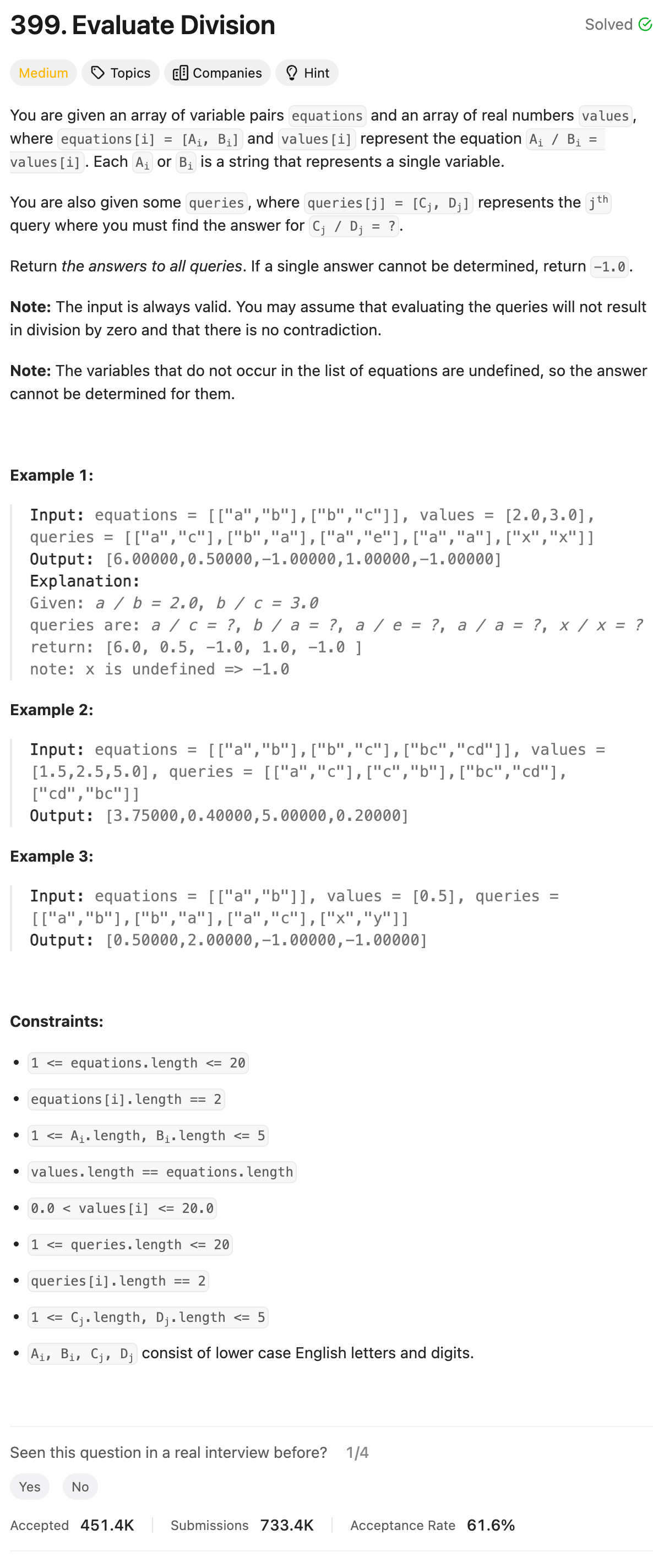Problem of The Day: Evaluate Division
Problem Statement

Intuition
When initially approaching this problem, I recognized it as a graph problem involving traversing through equations and values to find the result of queries.
Approach
My approach involves constructing a graph using a defaultdict of lists where each node represents a variable in the equation, and the edges contain the value of the division between two variables. Then, I use depth-first search (DFS) to traverse the graph and compute the result of queries.
Complexity
-
Time complexity:
- Constructing the graph takes O(n) time, where nnn is the number of equations.
- DFS for each query takes O(n) time in the worst case, where nnn is the number of variables. Overall, the time complexity is O(n^2).
-
Space complexity: O(n), where n is the number of equations, as we store the graph and visited nodes.
Code
class Solution:
def calcEquation(self, equations: List[List[str]], values: List[float], queries: List[List[str]]) -> List[float]:
graph = defaultdict(list)
res = []
for i, [src, dest] in enumerate(equations):
graph[src].append((dest, values[i]))
graph[dest].append((src, 1 / values[i]))
def dfs(src, dest, curr, visited):
if src == dest:
return curr
if src in visited:
return -1.0
visited.add(src)
res = -1.0
for node, val in graph[src]:
res = dfs(node, dest, curr * val, visited)
if res != -1.0:
return res
return res
for src, dest in queries:
if src not in graph or dest not in graph:
res.append(-1.0)
elif src == dest:
res.append(1.0)
else:
res.append(dfs(src, dest, 1, set()))
return res
Editorial Solution
Approach 1: Path Search in Graph
class Solution:
def calcEquation(self, equations: List[List[str]], values: List[float], queries: List[List[str]]) -> List[float]:
graph = defaultdict(defaultdict)
def backtrack_evaluate(curr_node, target_node, acc_product, visited):
visited.add(curr_node)
ret = -1.0
neighbors = graph[curr_node]
if target_node in neighbors:
ret = acc_product * neighbors[target_node]
else:
for neighbor, value in neighbors.items():
if neighbor in visited:
continue
ret = backtrack_evaluate(
neighbor, target_node, acc_product * value, visited)
if ret != -1.0:
break
visited.remove(curr_node)
return ret
# Step 1). build the graph from the equations
for (dividend, divisor), value in zip(equations, values):
# add nodes and two edges into the graph
graph[dividend][divisor] = value
graph[divisor][dividend] = 1 / value
# Step 2). Evaluate each query via backtracking (DFS)
# by verifying if there exists a path from dividend to divisor
results = []
for dividend, divisor in queries:
if dividend not in graph or divisor not in graph:
# case 1): either node does not exist
ret = -1.0
elif dividend == divisor:
# case 2): origin and destination are the same node
ret = 1.0
else:
visited = set()
ret = backtrack_evaluate(dividend, divisor, 1, visited)
results.append(ret)
return results
Approach 2: Union-Find with Weights
Need to review this approach again to understand it more
class Solution:
def calcEquation(self, equations: List[List[str]], values: List[float], queries: List[List[str]]) -> List[float]:
gid_weight = {}
def find(node_id):
if node_id not in gid_weight:
gid_weight[node_id] = (node_id, 1)
group_id, node_weight = gid_weight[node_id]
# The above statements are equivalent to the following one
#group_id, node_weight = gid_weight.setdefault(node_id, (node_id, 1))
if group_id != node_id:
# found inconsistency, trigger chain update
new_group_id, group_weight = find(group_id)
gid_weight[node_id] = \
(new_group_id, node_weight * group_weight)
return gid_weight[node_id]
def union(dividend, divisor, value):
dividend_gid, dividend_weight = find(dividend)
divisor_gid, divisor_weight = find(divisor)
if dividend_gid != divisor_gid:
# merge the two groups together,
# by attaching the dividend group to the one of divisor
gid_weight[dividend_gid] = \
(divisor_gid, divisor_weight * value / dividend_weight)
# Step 1). build the union groups
for (dividend, divisor), value in zip(equations, values):
union(dividend, divisor, value)
results = []
# Step 2). run the evaluation, with "lazy" updates in find() function
for (dividend, divisor) in queries:
if dividend not in gid_weight or divisor not in gid_weight:
# case 1). at least one variable did not appear before
results.append(-1.0)
else:
dividend_gid, dividend_weight = find(dividend)
divisor_gid, divisor_weight = find(divisor)
if dividend_gid != divisor_gid:
# case 2). the variables do not belong to the same chain/group
results.append(-1.0)
else:
# case 3). there is a chain/path between the variables
results.append(dividend_weight / divisor_weight)
return results